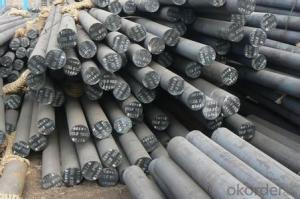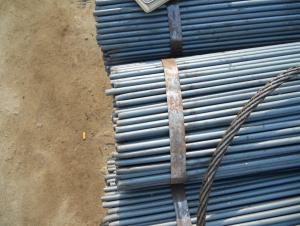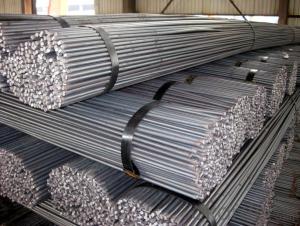Roung BAR
- Loading Port:
- China Main Port
- Payment Terms:
- TT OR LC
- Min Order Qty:
- -
- Supply Capability:
- -
OKorder Service Pledge
OKorder Financial Service
You Might Also Like
Product Description:
Specifications of High Quality Round Bar
1. Grade: GB, JIS, ASTM, EN
2. Grade: Q235, SS400, A36, S235JR
3. Diameter and mass: As below
Diameter | Mass | Diameter | Mass | Diameter | Mass |
(mm) | (kg/m) | (mm) | (kg/m) | (mm) | (kg/m) |
6 | 0.22 | 22 | 2.98 | 53 | 17.30 |
7 | 0.30 | 24 | 3.55 | 56 | 19.30 |
8 | 0.40 | 25 | 3.85 | 60 | 22.20 |
9 | 0.50 | 26 | 4.17 | 63 | 24.50 |
10 | 0.62 | 28 | 4.83 | 65 | 26.00 |
11 | 0.75 | 30 | 5.55 | 70 | 30.20 |
12 | 0.89 | 32 | 6.31 | 75 | 34.70 |
13 | 1.04 | 34 | 7.13 | 80 | 39.50 |
14 | 1.21 | 36 | 7.99 | 85 | 44.50 |
15 | 1.39 | 38 | 8.90 | 90 | 49.90 |
16 | 1.58 | 40 | 9.86 | 95 | 55.60 |
17 | 1.78 | 42 | 10.90 | 100 | 61.70 |
18 | 2.00 | 45 | 12.50 | 120 | 88.85 |
19 | 2.23 | 48 | 14.20 | 140 | 120.93 |
20 | 2.47 | 50 | 15.40 | 150 | 138.82 |
4. Material: Mild Steel
5. Heat treatment of high quality steel:
Fire: Isothermal annealing temperature is 800 ~ 880 °C, with 10 ~ 20 °C, the furnace cooling to about 600 °C, hardness above HB269.
Preheat temperature: 730-730 °C
Quenching temperature: 1190-1210 °C
Tempering temperature: 540-595 °C
Cold drawn, hardness 285 HBS
Cold drawn after annealing condition, hardness 277 HBS
Quenching methods: oil quenching, air cooling or salt bath quenching
Usage and Applications of High Quality Round Bar
1) Suitable for making various strong cutting tool abrasion resistance, impact resistance.
2) Used to produce all kinds of high hard and super hard saw blade, drill, tap, broach, gear hob and various kinds of milling cutter.
3) Used for advanced punching die, screw die, and the toughness and complicated shape of the punch, etc.
4) Is used for cold forging die and drawing mode, etc.
5) Recommended watchcase factory, screw factory and other cold stamping products industry use.
Packaging & Delivery of High Quality Round Bar
Packaging Detail: All goods are packed in bundle with steel strips and shipped by break bulk vessel or container (depend on target market and different ports)
Delivery Detail: 45 days
Trade terms: FOB, CFR, CIF
MOQ: 25 tons per specification; we can negotiate the quantity if the specification is normal or we have stock of one specification.
Weight: Theprice invoicing on theoretical weight basis or actual weight basis depends on customer’s request.
Shipment: The shipment of bulk break or container is depends on customer’s request and the situation of the port of destination.
Documents given: Full set of original clean on board bill of lading; Original signed commercial invoice; Original packing list; Policy of insurance; Certificate of origin and what the target market needs.
Production Flow of High Quality Round Bar
The common processes are preheated forging quenching, dual refinement solution process, cooling quenching and isothermal quenching. We use heat treatment for dual refinement solution process. The main measures process is high temperature solution and refinement cycle. High temperature solution can improve the carbide morphology and particle size. The aim is to make the loop refinement ultrafine austenite grains.
- Q:How are steel round bars tested for quality and strength?
- To ensure that steel round bars meet the necessary standards and specifications, various methods are employed to test their quality and strength. One commonly used test is the tensile test, which measures the bar's ability to withstand tension. In this test, a sample of the steel bar is gradually loaded until it reaches its breaking point, and the maximum load it can handle is recorded, along with the sample's elongation and reduction in area. These values offer valuable insights into the bar's strength and ductility. Another test employed is the hardness test, which assesses the steel bar's resistance to indentation or penetration. This test utilizes a hardness testing machine that applies a specific force to a small indenter, such as a diamond or a steel ball, and measures the resulting indentation's depth or size. The obtained hardness values can indicate the bar's strength and its ability to withstand wear and deformation. Apart from these mechanical tests, non-destructive testing methods are also used for steel round bars. Ultrasonic testing is a common technique employed to identify internal defects or inconsistencies in the bar's structure. This method involves transmitting high-frequency sound waves through the bar and analyzing the reflected waves to detect any irregularities. Magnetic particle inspection is another non-destructive test that relies on magnetic fields and particles to identify surface or near-surface defects in the steel bar. Chemical analysis plays a crucial role in determining the quality of steel round bars. This analysis involves testing the steel's composition to ensure it meets the required chemical specifications. It helps identify the presence of impurities or elements that could impact the bar's performance and durability. In summary, steel round bars undergo a combination of mechanical, non-destructive, and chemical tests to evaluate their quality and strength. These tests provide manufacturers with essential information, enabling them to ensure that the bars meet the necessary standards and are suitable for their intended applications.
- Q:Can steel round bars be bent or formed?
- Steel round bars have the capability to be bent or formed, depending on several factors such as the type of steel, bar diameter and thickness, and the chosen bending or forming method. There are various techniques available for bending or forming steel round bars, including hot bending, cold bending, and mechanical bending. In hot bending, the steel round bar is heated to a specific temperature and then shaped according to the desired form. On the other hand, cold bending does not require any heating and can be accomplished using hydraulic or manual bending machines. Mechanical bending, however, involves the utilization of specialized machinery to apply force and bend the steel round bar. It is vital to note that excessive bending or forming may weaken the steel round bar and affect its structural integrity. Hence, it is crucial to adhere to proper bending and forming techniques and consider the manufacturer's limitations and industry standards.
- Q:Can steel round bars be used for hydraulic cylinder applications?
- Yes, steel round bars can be used for hydraulic cylinder applications. Steel round bars are often used in the construction of hydraulic cylinders due to their high strength and durability. They provide excellent resistance to impact, corrosion, and wear, making them suitable for heavy-duty applications. Additionally, steel round bars can be easily machined and fabricated to meet specific dimensional requirements for hydraulic cylinder components. Therefore, steel round bars are a popular choice for hydraulic cylinder applications.
- Q:What are the common applications of steel round bars?
- Steel round bars are widely used in various industries due to their strength, versatility, and durability. Some common applications of steel round bars include: 1. Construction: Steel round bars are commonly used in construction projects such as building frames, bridges, and infrastructure. They provide structural support and can withstand heavy loads. Additionally, steel round bars are often used as reinforcement in concrete structures, increasing their strength and resilience. 2. Manufacturing: Steel round bars are utilized in the manufacturing industry for the production of various components and machinery. They are commonly used in the fabrication of gears, shafts, couplings, and axles, as they possess excellent machinability and can withstand high levels of stress and pressure. 3. Automotive: Steel round bars are extensively used in the automotive industry for manufacturing critical components like crankshafts, steering systems, suspension parts, and axles. Due to their high tensile strength and resistance to wear and tear, steel round bars play a crucial role in ensuring the safety and reliability of vehicles. 4. Aerospace: The aerospace industry relies heavily on steel round bars for the production of aircraft components, including landing gear, propeller shafts, and structural elements. Steel's high strength-to-weight ratio and excellent fatigue resistance make it an ideal choice for withstanding the extreme conditions experienced in aerospace applications. 5. Energy and power: Steel round bars are used in the energy and power sector for manufacturing equipment like turbines, generators, and power transmission systems. Steel's ability to handle high temperatures and its resistance to corrosion make it a suitable material for these applications. 6. Oil and gas: Steel round bars find extensive use in the oil and gas industry for the production of drilling equipment, pipelines, and valves. Steel's resistance to corrosion and high-pressure environments makes it an essential material in this sector. In summary, steel round bars have a wide range of applications across industries due to their strength, versatility, and resistance to wear and tear. They play a crucial role in construction, manufacturing, automotive, aerospace, energy, and power, as well as the oil and gas industry.
- Q:Can steel round bars be heat treated?
- Yes, it is possible to heat treat steel round bars. Heat treatment involves controlled heating and cooling of the steel to alter its physical and mechanical properties. Various heat treatment processes can be used on steel round bars, including annealing, normalizing, quenching, and tempering. Annealing is a heat treatment method where the steel is heated to a specific temperature and held there for a certain period of time. It is then slowly cooled. This process is used to soften the steel, improve its machinability, and reduce internal stresses. Normalizing is similar to annealing, but the cooling is done in air. It is often employed to refine the grain structure of the steel and enhance its overall strength and toughness. Quenching is a rapid cooling process where the steel round bars are immersed in a quenching medium, such as oil or water, to cool them quickly. This process increases the hardness and strength of the steel. However, it also makes the steel more brittle. Therefore, it is often followed by tempering to reduce brittleness and improve toughness. Tempering involves reheating the hardened steel to a specific temperature and holding it there for a certain period of time. It is then slowly cooled. This process helps to reduce the hardness and brittleness caused by quenching, while still maintaining a desirable level of strength and toughness. In summary, heat treatment is a versatile process that can be applied to steel round bars to achieve a wide range of desired properties, such as hardness, strength, toughness, and machinability.
- Q:What are the different surface treatments available for steel round bars?
- There are several surface treatments available for steel round bars, including: 1. Pickling and Passivation: This process involves removing impurities and oxides from the surface of the steel using an acid solution, followed by the application of a passivation treatment to enhance corrosion resistance. 2. Hot-dip Galvanizing: Steel round bars can be immersed in a bath of molten zinc, which forms a protective coating on the surface. This treatment provides excellent corrosion resistance. 3. Electroplating: This process involves applying a thin layer of metal, such as chromium or nickel, onto the surface of the steel round bar using an electrochemical method. It enhances the aesthetic appearance and provides some level of corrosion resistance. 4. Powder Coating: A dry powder is applied electrostatically to the steel round bar and then cured under heat. This results in a durable and protective coating that is resistant to corrosion, chemicals, and UV radiation. 5. Nitriding: In this treatment, the steel round bar is exposed to a nitrogen-rich atmosphere at high temperatures. This forms a hard and wear-resistant surface layer, improving the bar's performance in applications where hardness and durability are important. 6. Chrome Plating: A layer of chromium is electroplated onto the surface of the steel round bar, providing both aesthetic appeal and corrosion resistance. These are just a few examples of the different surface treatments available for steel round bars, and the choice depends on the specific requirements of the application, such as corrosion resistance, durability, and aesthetic considerations.
- Q:What is the difference between hot working and cold working of steel round bars?
- Steel round bars can be shaped and manipulated using two different methods: hot working and cold working. Hot working involves shaping steel at high temperatures, typically above the steel's recrystallization temperature. This makes the material more malleable and easier to shape. The processes involved in hot working include forging, rolling, and extrusion. Hot working has several advantages. It allows for the creation of complex shapes and sizes with minimal force or energy. It also improves the mechanical properties of the steel, such as strength and toughness, by refining its grain structure. However, hot working can cause oxidation and scale formation on the steel's surface, which may require additional treatments or cleaning. On the other hand, cold working refers to shaping steel at room temperature or below its recrystallization temperature. Cold working processes include bending, drawing, and cold rolling. Unlike hot working, cold working does not require heating the steel, which reduces energy consumption and production costs. It also results in a smoother surface finish and tighter tolerances compared to hot working. Cold working can increase the hardness and strength of the steel, making it suitable for applications that require higher mechanical properties. However, it can also make the steel more brittle and prone to cracking. In conclusion, the main difference between hot working and cold working steel round bars lies in the temperature at which the shaping process takes place. Hot working is done at high temperatures, making shaping easier and improving mechanical properties. Cold working, on the other hand, is done at room temperature or below, resulting in tighter tolerances and increased hardness. The choice between hot working and cold working depends on the desired properties and characteristics of the final product.
- Q:Can steel round bars be used for making cooling system components?
- Certainly, cooling system components can be fabricated using steel round bars. Steel, being a versatile and resilient material, possesses the capability to endure elevated temperatures and pressures, rendering it ideal for cooling system applications. Steel round bars can be precisely shaped and dimensioned to meet the varying requirements of distinct cooling system components such as pipes, fittings, valves, and heat exchangers. Furthermore, steel exhibits exceptional thermal conductivity, enabling efficient heat transfer within cooling systems. However, it is vital to meticulously consider the specific demands of the cooling system and seek advice from engineers or professionals to ascertain the appropriate grade of steel and ensure compatibility with other system components.
- Q:Can steel round bars be used for making wheel hubs?
- Yes, steel round bars can be used for making wheel hubs. Steel is a common material choice for wheel hubs due to its high strength and durability, making it suitable for withstanding the forces and pressures experienced by wheel hubs during operation.
- Q:Can steel round bars be heat treated for improved strength?
- Yes, steel round bars can be heat treated to improve their strength. Heat treatment involves heating the steel to a specific temperature and then cooling it rapidly or slowly, depending on the desired outcome. This process can alter the microstructure of the steel, resulting in increased hardness, tensile strength, and other mechanical properties.
1. Manufacturer Overview |
|
|---|---|
| Location | |
| Year Established | |
| Annual Output Value | |
| Main Markets | |
| Company Certifications | |
2. Manufacturer Certificates |
|
|---|---|
| a) Certification Name | |
| Range | |
| Reference | |
| Validity Period | |
3. Manufacturer Capability |
|
|---|---|
| a)Trade Capacity | |
| Nearest Port | |
| Export Percentage | |
| No.of Employees in Trade Department | |
| Language Spoken: | |
| b)Factory Information | |
| Factory Size: | |
| No. of Production Lines | |
| Contract Manufacturing | |
| Product Price Range | |
Send your message to us
Roung BAR
- Loading Port:
- China Main Port
- Payment Terms:
- TT OR LC
- Min Order Qty:
- -
- Supply Capability:
- -
OKorder Service Pledge
OKorder Financial Service
Similar products
New products
Hot products
Related keywords































